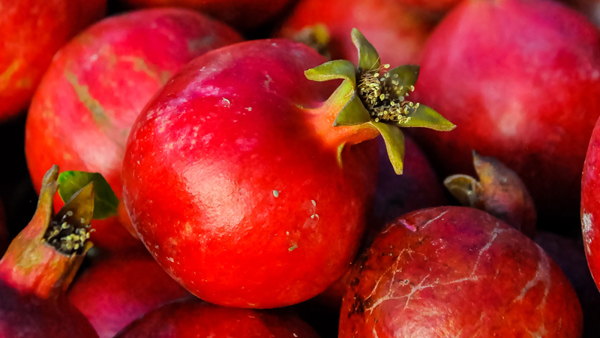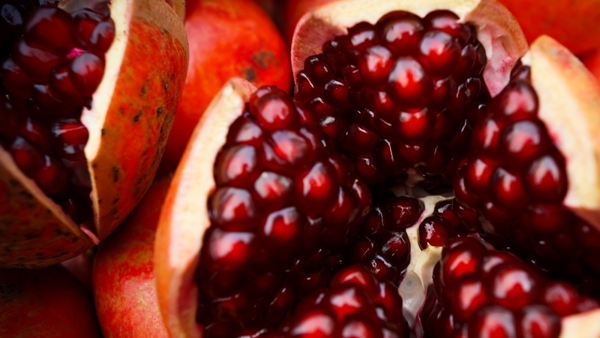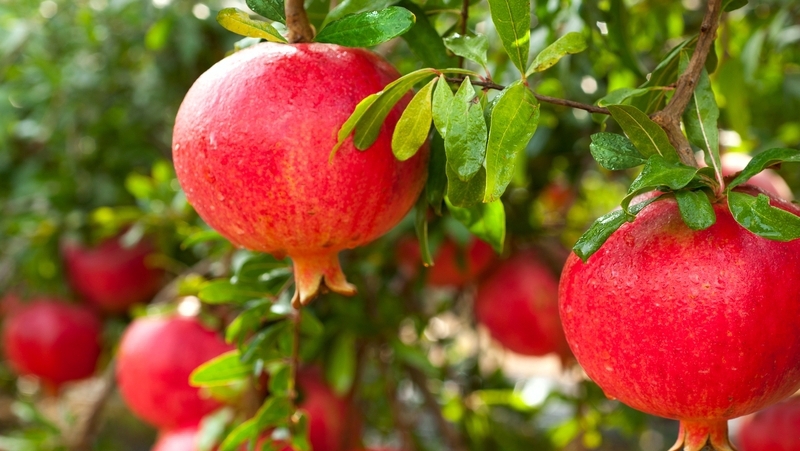Yates Account
Join now
Create a Yates account today!
Sign up to join the Yates Garden Club for monthly e-mails packed with seasonal inspiration, tips for success & exclusive promotions.
Plus if you’re a Garden Club member you can take part in the Yates Growing Community - a blog to share successes, get advice & win prizes in fun challenges along the way!

Forgot password
Enter the email address associated with your account, and we'll email you a new password.

Is there a prettier fruit than the ruby red jewels (well, technically arils) of pomegranate (Punica granatum) We know, they can be fiddly to eat, but they’re just so full of flavour and impart a wonderful pop of colour to platters and salads! Plus, they’re known to contain high levels of antioxidants, so you know they’re good for you, too. They’re easy to grow at home, but you’ll have to wait a couple of years before you can harvest. But in the mean, enjoy the glossy green leaves and gorgeous red-orange blooms.
How to grow Pomegranates in a garden
- Choose a sunny spot with well drained soil. Enrich the soil with Yates Dynamic Lifter Organic Plant Food. If the soil is clay based, improve soil structure by adding gypsum and forking in well.
- Planting:
- If planting bare-rooted plants in winter, soak in a bucket of water for 30 minutes prior to planting. Remove from bucket, position in hole and backfill with soil, gently firming down.
- If planting a potted plant, dig the planting hole twice as wide and to the same depth as the root-ball. Remove the plant from the container, gently tease the roots and cut away any circled or tangled roots. - Position plant in hole and backfill with soil, gently firming down. Form a raised doughnut shaped ring of soil around the outer edge of the plant's root zone. This helps keep water where it's needed. Always water in well after planting to settle the soil around the roots and keep the soil moist for several weeks while the new plant establishes.
- Mulch around the base with organic mulch like woodchip or pea straw, keeping it away from the trunk.
- Water deeply, once or twice a week, depending on weather conditions.
- During the growing and flowering/fruiting season, feed with Yates Thrive Citrus & Fruit Granular Plant Food. TIP: for an added boost during the flowering/fruiting season, apply Yates Thrive Natural Citrus & Fruit Plant Food Concentrate.


How to grow Pomegranates in a pot
Pomegranates are perfect pot specimens, particularly dwarf forms like ‘Nana’ which only grow to 1m.
- Choose a pot at least 500mm wide - the larger the better. Position in full sun and fill with quality potting mix, such as Yates Nature's Way Organic Citrus & Fruit Mix.
- Remove the plant from the container, gently tease the roots and cut away any circled or tangled roots.
- Position in hole and backfill with potting mix, gently firming down. Water in well.
- Water deeply, 2-3 times during the week, depending on weather conditions.
- During the growing and flowering/fruiting season, feed weekly with Yates Thrive Natural Citrus & Fruit Plant Food Concentrate. Throughout the year apply Yates Thrive Fish Blood & Bone Plant Food Concentrate.

Growing tips
- Pomegranates are perfect pot specimens, particularly dwarf forms like ‘Nana’, which only grow to 1m.
- Prune suckers (growth appearing from the soil or below the knobbly graft union on the trunk) regularly. They do not produce fruit and take energy away from the tree.
- Lightly prune after fruiting to help maintain shape and remove any dead/diseased/damaged growth.
- Harvesting is usually from March through to May when the skin turns orange-brown. This can differ between varieties, so make sure you check the label.
- Purchase and plant bare-rooted plants from late autumn to early spring.
- Potted plants can be bought during the warmer months of the year for planting.
More Plants
Feijoa trees are a familiar sight in kiwi gardens; they're also a great choice for an edible hedge. The delicious fruit can be eaten fresh; they’re also perfect for using in cakes, muffins, jams, cocktails, desserts, fruit salad and smoothies.
Currants
Tart and sweet, blackcurrant and redcurrant fruit have a short summer season, so grab them while you can.
Strawberry
Strawberries happily grow in raised garden beds, in the garden, in pots or even hanging baskets. Eat them fresh, cooked or make into jams.
Apples
Apples can grow into large trees, but you can also find dwarf forms. Be sure to find a self-fertile variety or two which can cross-pollinate.
Yates Thrive Citrus & Fruit Granular Plant Food
Fast acting, gradual feeding plant food specially formulated to grow citrus & fruit trees, with high potassium for more abundant fruit & added magnesium to help prevent leaf yellowing.
Yates Thrive Natural Citrus & Fruit Plant Food Concentrate
Specially developed for boosting healthy yields of juicy fruit in citrus & other fruiting plants. Feeds through both leaves and roots for fast results.
Yates Dynamic Lifter Organic Plant Food
Releases nutrients slowly, improves the structure and moisture retention of the soil and encourages earthworms and beneficial soil micro-organisms.
















Share
Share this article on social media